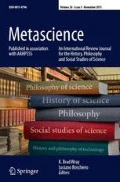As our readers know, one of the joys of being a scholar is travelling to academic conferences to find out what is new in the field, forge new connections and catch up with old friends. We had the good fortune of doing just that at the 7th Panhellenic Conference on Philosophy of Science at the National & Kapodistrian University of Athens this past December. Thank you to Stavros Ioannidis and his colleagues at the Department of History & Philosophy of Science at the University of Athens for inviting us to Athens and doing everything possible to ensure that we were comfortable and had everything we needed.
The conference was a delightful reminder of the vibrancy of the history and philosophy of science community. There were numerous engaging and thoughtful presentations by scholars, young and old, from Greece and elsewhere. The talks covered a great range of topics, including theoretical pluralism, causation, history and philosophy of chemistry, and machine learning, attesting to the great range of interests and expertise of scholars in our field. Brad was a commentator in a session on Thomas Kuhn’s Legacy, in honour of the 60th anniversary of the publication of The Structure of Scientific Revolutions. The centrepiece of the session was Vasso Kindi’s engaging presentation: “Kuhn’s Controversial Legacy”. There were many opportunities to continue the philosophical discussions that began at the conference in nearby cafes and restaurants at lunch, over souvlaki, or at late night dinners in tavernas. It was also a perfect opportunity to connect with the former editorial team of Metascience—Stathis Psillos, Theodore Arabatzis and Vassilis Sakellariou—as well as some Metascience reviewers, whom we had never met in person, Federica Russo, Vanessa Seifert and Koray Karaca, as well as old friends, Alexander Bird and Vasso Kindi.
It was our first trip to Greece, so we added on some extra days to ensure that we had time to visit the ancient sites. Our first visit, as you might expect, was to the Acropolis.
We had been warned about the crowds at the Acropolis, so we went early. We also took the advice of our hotel staff and went through the far less-used side entrance. Going up the side of the Acropolis was an interesting experience, not only for the experience of imagining what it might have been like to be Socrates, Plato or Aristotle ascending the sloping path upward, but also because we encountered something we had not expected—cats. Cats are ubiquitous in Athens. Neither of us remembered ever having read or heard about the cats of Athens. Had there always been so many cats? We cannot recall any mention of them in The Republic, which is after all, a model for the perfect city. Perhaps Plato thought of cats as a given?
While at the Acropolis, we were fortunate enough to experience something truly amazing—a double rainbow. Although we had experienced double rainbows before—our first when we were in the Rocky Mountains of Canada—we never tire of seeing them. Not having visited the Acropolis before, we thought that rainbows here might be quite common, like cats. But when we noticed that the staff and guards at the Acropolis were reaching for their phones and taking as many pictures as the tourists, we knew that we were experiencing something rare. The rainbow stretched across the sky, with one end passing behind the Erechtheion, the building famous for the so-called porch of maidens. So, what had already been a stunning aesthetic experience became even more so.
By the time that we were beginning our descent from the Acropolis, the site had become quite crowded. There was even a group of young Greek soldiers there, in their uniforms but clearly in the role of tourists rather than soldiers. From the excitement that they displayed, we guessed that it was their first time visiting the Acropolis as well.
We also went to Aristotle’s Lyceum, which was a seven-minute walk from our hotel. Our visit to the Lyceum was quite in contrast to that of the Acropolis. We were there on a rainy day, and we were the only two there, apart from the cats. Though principally an archaeological site, we did feel that there was enough there to allow us to begin to imagine what it might have been like to be a student or teacher at the Lyceum.
We did not visit Plato’s Academy. It is far from the city centre, and as far as we can tell, it is very difficult to get to by public transit. We did, though, get the chance to visit the Ancient Agora, the Pnyx, and the cave where it is thought that Socrates was imprisoned. While we were at “Socrates’ prison”, we noticed that there was a young couple having a picnic on a bench close to the opening of the cave. Had they come here as a kind of pilgrimage? We wondered.
The conference and the trip were great reminders of the pleasures of leading a philosophical and academic life, a life in dialogue with others. They were also reminders that this kind of life is not new and hopefully one that will continue long into the future.
Author information
Authors and Affiliations
Corresponding author
Additional information
Publisher's Note
Springer Nature remains neutral with regard to jurisdictional claims in published maps and institutional affiliations.
Rights and permissions
About this article
Cite this article
Wray, K.B., Nash, L. Metascience builds connections. Metascience 32, 1–2 (2023). https://doi.org/10.1007/s11016-023-00845-w
Accepted:
Published:
Issue Date:
DOI: https://doi.org/10.1007/s11016-023-00845-w

